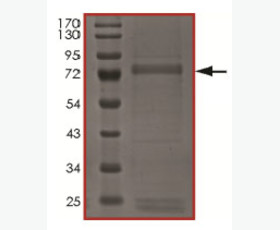Recombinant Human Apurinic-Apyrimidinic Endonuclease 1/APE
| Product name: | Recombinant Human Apurinic-Apyrimidinic Endonuclease 1/APE |
| Source: | E.coli |
| Purity: | Greater than 95% as determined by reducing SDS-PAGE. |
| Buffer Formulation: | Supplied as a 0.2 μm filtered solution of 10mM HEPES, 100mM KCl, 50% Glycerol, pH 7.4. |
| Applications: | Applications:SDS-PAGE; WB; ELISA; IP. |
| Storage: | Avoid repeated freeze/thaw cycles. Store at 2-8 oC for one month. Aliquot and store at -80 oC for 12 months. |
| UOM: | 100ug/50ug/200ug/1mg/1g |
| Source | E.coli |
| Description | Recombinant Human Apurinic-Apyrimidinic Endonuclease 1 is produced by our E.coli expression system and the target gene encoding Pro2-Leu318 is expressed. |
| Names | DNA-(Apurinic or Apyrimidinic Site) Lyase, APEX Nuclease, APEN, Apurinic-Apyrimidinic Endonuclease 1, AP Endonuclease 1, APE-1REF-1, Redox Factor-1, APEX1, APE, APE1, APEX, APX, HAP1, REF1 |
| Accession # | P27695 |
| Formulation | Supplied as a 0.2 μm filtered solution of 10mM HEPES, 100mM KCl, 50% Glycerol, pH 7.4. |
| Shipping |
The product is shipped on dry ice/ice packs. |
| Storage |
Store at < -20°C, stable for 6 months after receipt. Please minimize freeze-thaw cycles. |
| Purity |
Greater than 95% as determined by reducing SDS-PAGE. |
| Endotoxin | Less than 0.1 ng/µg (1 IEU/µg) as determined by LAL test. |
| Amino Acid Sequence |
MGPKRGKKGAVAEDGDELRTEPEAKKSKTAAKKNDKEAAGEGPALYEDPPDQKTSPSGKPATLKI CSWNVDGLRAWIKKKGLDWVKEEAPDILCLQETKCSENKLPAELQELPGLSHQYWSAPSDKEGYS GVGLLSRQCPLKVSYGIGEEEHDQEGRVIVAEFDSFVLVTAYVPNAGRGLVRLEYRQRWDEAFRK FLKGLASRKPLVLCGDLNVAHEEIDLRNPKGNKKNAGFTPQERQGFGELLQAVPLADSFRHLYPN TPYAYTFWTYMMNARSKNVGWRLDYFLLSHSLLPALCDSKIRSKALGSDHCPITLYLAL
|
| Background | Apurinic-Apyrimidinic Endonuclease 1 (APE1) is required for efficient DNA base excision repair. When the DNA glycosylase remove the damaged bases, APE1 cleaves the AP site to allow resynthesis and ligation to complete repair. APE1 stimulates the DNA binding activity of many transcription factors, which participate in cancer promotion and progression. APE1 regulates the redox state of multiple transcription factors, such as c-Jun, c-Fos, NF-kB, p53. APEN is also involved in calcium-dependent down-regulation of PTH expression. |














